Birdfinding.info ⇒ Numerically the third-rarest, but generally considered to be the most endangered crane species, the Siberian Crane’s East Asian population appears to have stabilized and begun to recover. The most accessible site is Poyang Lake, which hosts the bulk of the global population from November through February.
Siberian Crane
Leucogeranus leucogeranus
Breeds on arctic tundra of Siberia. Winters in eastern China and southwestern Asia.
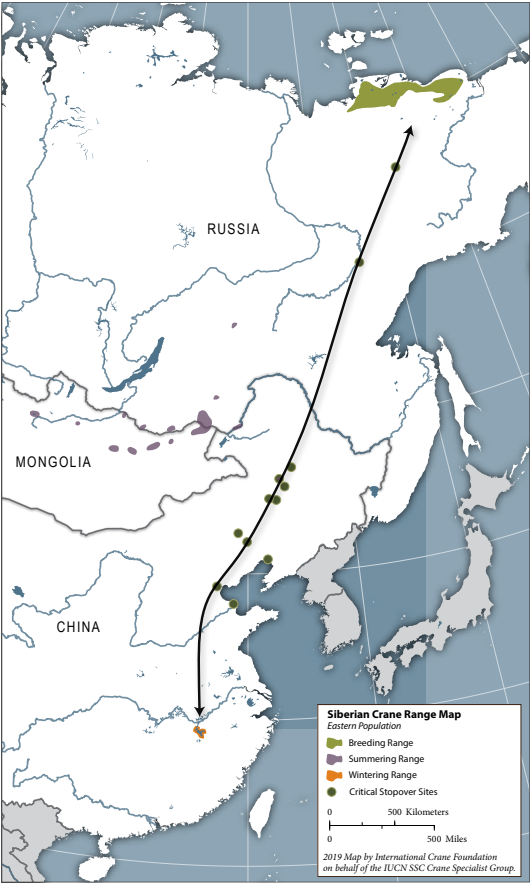
Approximate current distribution of the Siberian Crane. © International Crane Foundation 2019
Breeding. Most of the world population (estimated at ~3,600-4,000) nests on low-lying, marshy tundra of northeastern Siberia between the Yana and Kolyma Rivers.
Subadults range widely across northeastern Asia during the summer months, including areas in and around the breeding grounds, as well as various sites in Mongolia and the adjacent Transbaikalia region of Siberia.
A tiny remnant subpopulation breeds in western Siberia along the Ob River, but it is on the verge of extirpation and generally believed to have declined too far to be genetically or demographically viable. As of the late 2010s, approximately 10-20 birds were still seen annually on the breeding grounds and at favored migration staging sites.
Since the 1990s Russian conservation biologists have attempted to restore the western subpopulation through releases of captive-bred young (181 individuals between 1991 and 2016) and the introduction of eggs into Common Crane nests, but so far these efforts have had no durable results.
Nonbreeding. The vast majority of global population winters in east-central China in the Yangtze River Valley between Yueyang and Shanghai. Most of these birds spend most of the winter in the Poyang Lake wetland complex. Isolated individuals and small flocks wander west into Hunan and east to the coastal lowlands of Jiangsu and Zhejiang, and exceptionally much farther south, north, and east.
According to Mirande and Ilyashenko (2019): “Poyang Lake offers reliable wintering habitat to over 400,000 waterbirds each winter due to the remarkable fluctuations in water levels that occur between summer and winter. For most of the year, Poyang empties into the Yangtze River, but during summer floods Yangtze waters may flow the other way, into Poyang Lake. The rainy season extends through the warm seasons, after which water levels drop dramatically in autumn, falling as much as 11 m to expose vast shallows and mud flats in winter. Wind moves shallow water across this flat basin, so that feeding areas are diverse and constantly changing and thus can support East Asia’s largest concentration of wintering waterbirds.”
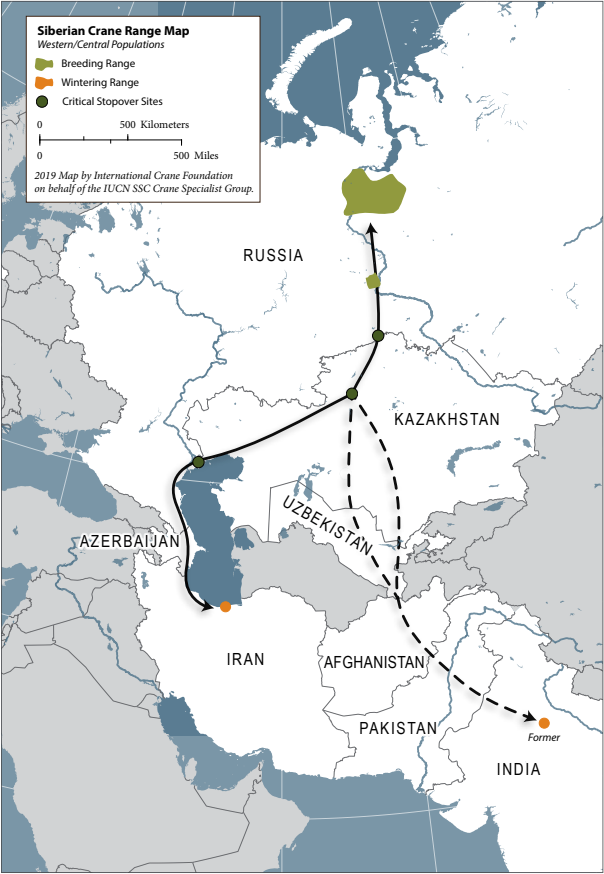
Approximate distribution of the Siberian Crane’s near-extirpated western subpopulation. © International Crane Foundation 2019
A few stragglers sometimes winter elsewhere in eastern China. Exceptional individuals have been found wintering farther afield: with recent records from Hong Kong, Taiwan, and Japan.
The western breeding population formerly wintered at two known sites: along the southern shore of the Caspian Sea in northwestern Iran; and Keoladeo National Park in northern India. The last appearance of Siberian Cranes at Keoladeo was a pair that spent the winter of 2001-02. Meanwhile, at the traditional site in Iran, since the winter of 2006-07, only a single crane has appeared—an individual named Omid who has been reported returning into the 2020s. The wintering grounds of the remaining western flock remain unknown—presumably somewhere in southwestern Asia.
Movements. Northbound migration begins in late February or early March, when most of the population depart Poyang Lake and move to staging areas in northeastern China. The vast majority accumulate at Momoge National Nature Reserve in northern Jilin, then proceed to the Aldan River basin in east-central Siberia.
Southbound migration begins in mid- to late August. The majority stage and feed at the same sites used in spring, most remaining in Siberia through September, spending October in northeastern China, and returning to the Yangtze River Valley around the end of October or early November.
The entire western subpopulation historically gathered in the Naurzum Lake system in the Kostanay Region of north-central Kazakhstan. From there, one flock continued south across Uzbekistan, Afghanistan, and Pakistan to northern India, while the other flock flew southwest to the Volga Delta and along the western shore of the Caspian Sea via Gyzyl-Agach Nature Reserve in Azerbaijan to Iran.
Identification
Unmistakable: a very large, white crane with black primaries, pinkish legs, a long pinkish bill, a bare red face, and pale-yellow eyes.
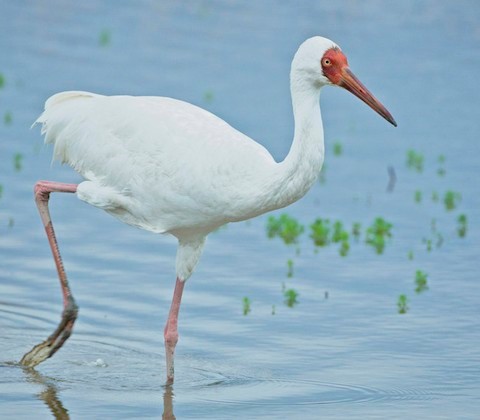
Siberian Crane. (Qingshui Wetland, Jinshan, Taiwan; January 2016.) © Koel Ko
The most aquatic of cranes, it is almost always found in wetlands with standing water.
The pattern of bare red skin on the face is distinctive: including the entire front portion of the head except for the throat. The pale eyes stand out prominently against the reddish skin.

Siberian Crane, close-up showing unique pattern of bare red facial skin. (Qingshui Wetland, Jinshan, Taiwan; November 16, 2015.) © Ximentin Chuang
At rest, the plumage appears all-white. When the wings are spread, the black on the primaries and upper primary coverts contrasts boldly. There is an isolated white wedge on the leading edge of the otherwise-black upper primary coverts.

Siberian Crane, displaying, showing black primaries. (Poyang Lake, Jiangxi, China; December 3, 2019.) © Wouter Van Gasse

Siberian Cranes in flight, showing black primaries—on the lefthand bird, note the white wedge on the leading edge of the primary coverts. (Poyang Lake, Jiangxi, China; December 30, 2021.) © Karl Hu
Immatures resemble adults overall, but are extensively orangish-brown over the upperparts—including the head and neck, with short orangish-brown feathering on the face.

Siberian Crane, juvenile. (Qingshui Wetland, Jinshan, Taiwan; January 4, 2015.) © Jerry Ting

Siberian Crane, subadult. (Qingshui Wetland, Jinshan, Taiwan; April 20, 2015.) © Sam Shaw
Notes
Monotypic species.
IUCN Red List Status: Critically Endangered.
More Images of the Siberian Crane

Siberian Crane, close-up showing unique pattern of bare red facial skin. (Qingshui Wetland, Jinshan, Taiwan; August 4, 2015.) © Christoph Moning

Siberian Crane. (Yilan, Taiwan; December 17, 2021.) © Arlango Lee

Siberian Crane, adult with immature at left and Bewick’s Swans at right for size comparison. (Poyang Lake, Jiangxi, China; December 3, 2019.) © Wouter Van Gasse
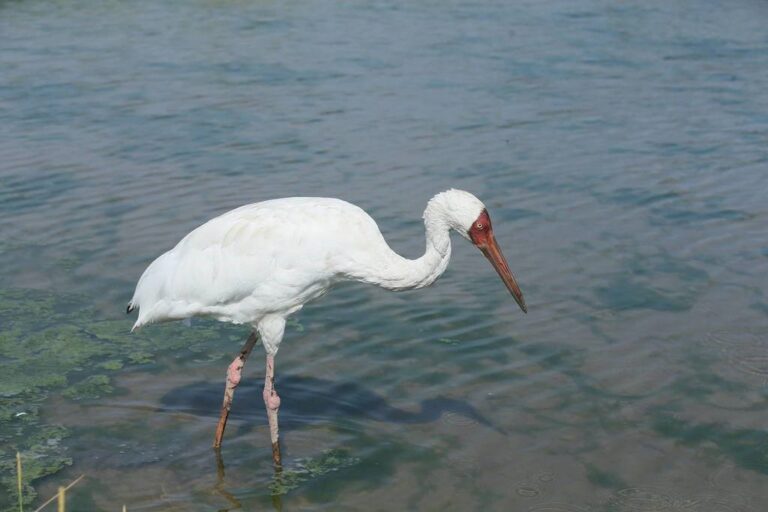
Siberian Crane. (Qingshui Wetland, Jinshan, Taiwan; September 5, 2015.) © Ting-Wei Hung
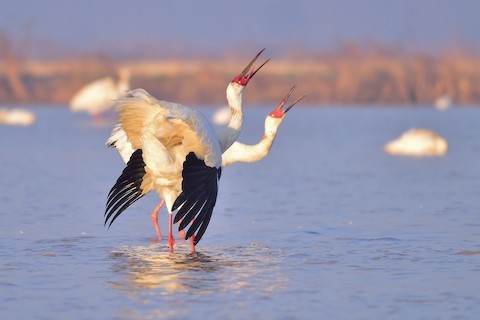
Siberian Cranes, vocalizing. (Star Farm, Poyang Lake, Jiangxi, China; January 11, 2018.) © Xiwen Chen

Siberian Crane, showing white wedge on the leading edge of the black upper primary coverts. (Quzhou, Zhejiang, China; December 30, 2020.) © 浙江重要鸟讯汇整
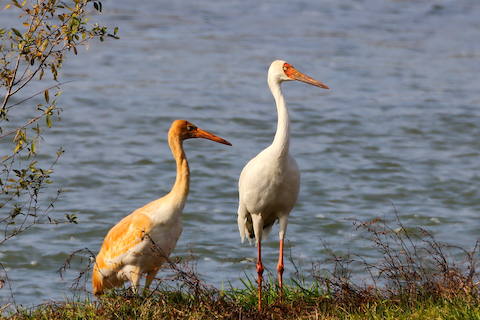
Siberian Crane, immature and adult. (Quzhou, Zhejiang, China; December 30, 2020.) © 浙江重要鸟讯汇整

Siberian Crane, adult and immature taking off. (Quzhou, Zhejiang, China; December 30, 2020.) © 浙江重要鸟讯汇整

Siberian Crane in flight, ventral view showing contrasting black primaries. (Yuhang, Zhejiang, China; November 11, 2021.) © 浙江重要鸟讯汇整
References
BirdLife International. 2018. Leucogeranus leucogeranus. The IUCN Red List of Threatened Species 2018: e.T22692053A134180990. https://dx.doi.org/10.2305/IUCN.UK.2018-2.RLTS.T22692053A134180990.en. (Accessed December 5, 2022.)
Brazil, M. 2009. Birds of East Asia. Princeton University Press.
eBird. 2022. eBird: An online database of bird distribution and abundance. Cornell Lab of Ornithology, Ithaca, N.Y. http://www.ebird.org. (Accessed December 5, 2022.)
Hughes, J.M. 2008. Cranes: A Natural History of a Bird in Crisis. Firefly Books, Richmond Hill, Ontario.
International Crane Foundation. 2022. Species Field Guide: Siberian Crane. https://savingcranes.org/learn/species-field-guide/siberian-crane/. (Accessed December 5, 2022.)
Mirande, C.M., and E.I. Ilyashenko. 2019. IUCN SSC Crane Specialist Group – Crane Conservation Strategy, Species Review: Siberian Crane (Leucogeranus leucogeranus). In Crane Conservation Strategy (C.M. Mirande, and J.T. Harris, eds.), 209-222. International Crane Foundation, Baraboo, Wisconsin.
Mullarney, K., L. Svensson, D. Zetterström, and P.J. Grant. 1999. Birds of Europe. Princeton University Press.
Xeno-Canto. 2022. Siberian Crane – Leucogeranus leucogeranus. https://xeno-canto.org/species/Leucogeranus-leucogeranus. (Accessed December 5, 2022.)
